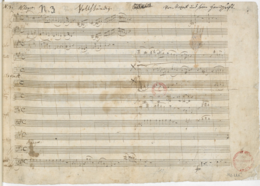Piano Concerto No. 23 (Mozart)
| Piano Concerto in A major | |
|---|---|
| No. 23 | |
| by W. A. Mozart | |
 The opening page of the autograph manuscript | |
| Key | A major |
| Catalogue | K. 488 |
| Genre | Concerto |
| Style | Classical period |
| Composed | 1786 |
| Published | 1800 |
| Movements | Allegro, Adagio, Allegro assai |
| Scoring |
|
The Piano Concerto No. 23 in A major K. 488 is a concerto for piano and orchestra written by Wolfgang Amadeus Mozart. It was finished, according to Mozart's own catalogue, on March 2, 1786, two months prior to the premiere of his opera, Le nozze di Figaro, and some three weeks prior to the completion of his next piano concerto. It was one of three subscription concerts given that spring and was probably played by Mozart himself at one of these.
The concerto is scored for piano solo and an orchestra consisting of one flute, two clarinets, two bassoons, two horns and strings.
Structure
The piano concerto has three movements and typically lasts for about 26 minutes:
- rondo form
The first movement is in A major and is in
The slow second movement, in ternary form, is somewhat operatic in tone. The piano begins alone with a theme in Siciliano rhythm characterized by unusually wide leaps. This is the only movement by Mozart in F♯ minor.[1] The dynamics are soft throughout most of the piece. The middle of the movement contains a brighter section in A major announced by flute and clarinet that Mozart would later use to introduce the trio "Ah! taci ingiusto core!" in his 1787 opera Don Giovanni.[2]
The third movement is a
Reception
References
- ISBN 978-0-435-81420-5
- ISBN 0-486-21271-8.
- ^ Girdlestone, pp. 384–386.
- ^ Peres Da Costa 2012, 87.
- ^ Peres Da Costa 2012, 84–88.
- ^ Peres Da Costa 2012, 70–71, 86.
Bibliography
- ISBN 978-0-19-538691-2.
External links
 Media related to Piano Concerto No. 23 (Mozart) at Wikimedia Commons
Media related to Piano Concerto No. 23 (Mozart) at Wikimedia Commons- Konzert für Klavier und Orchester in A KV 488: Score and critical report (in German) in the Neue Mozart-Ausgabe
- Piano Concerto No. 23, K. 488: Scores at the International Music Score Library Project
